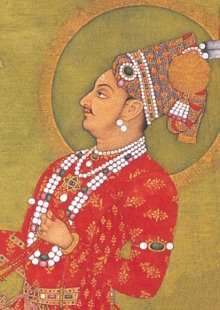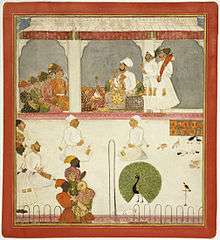Abhai Singh of Marwar
Maharaja Abhai Singh Rathore (7 November 1702 – 18 June 1749) was the Raja of Marwar (Jodhpur) Kingdom (r. 24 June 1724 – 18 June 1749).[1][2]
| Maharaja Abhai Singh Rathore | |
|---|---|
| Maharaja of the Jodhpur | |
 | |
| Tenure | 24 June 1724 – 18 June 1749 |
| Coronation | 17 July 1724, Delhi |
| Born | 7 November 1702 Meherangarh, Jodhpur |
| Died | 18 June 1749 (aged 46) Ajmer |
| House | Rathore |
| Father | Ajit Singh |
| Religion | Hinduism |
Coronation

Abhai Singh was crowned on the death of this father Maharaja Ajit Singh who himself was killed by a conspiracy of Abhai Singh and Bakht Singh. He was nonetheless as fearless as his father.
Khejarli Massacre
In 1726, Maharaja Abhai Singh of Marwar granted the estate of Khejarli to Thakur Surat Singh, who he became the first 'Thakur of Khejarli'.
In 1730, under his order, a minister Giridhar Bhandari, led a royal party to the Khejarli village with the fell done Khejari trees.
A local woman called Amrita Devi Bishnoi protested against the tree-felling because such acts were prohibited by the Bishnoi's religion. The feudal party said that they would only cease if she paid them a bribe, which she refused to do because she saw that as ignominious and an insult to her faith. She said that she would rather give away her life to save the trees. She and her three daughters (Asu, Ratni and Bhagu) were then killed by the party.[3]
News of the deaths spread and summons to a meeting were sent to 84 Bishnoi villages. The meeting determined that one Bishnoi volunteer would sacrifice their life for every tree that was cut down. Older people began hugging the trees that were intended to be cut and many were killed.[3]
These efforts failed to have the desired impact and Bhandari claimed that the Bishnois were sacrificing ageing people whom they no longer saw as useful to society. In response to this, young men, women and children began to follow the example of the old. 363 Bishnois died in the incident.[3]
The development shocked the tree-felling party. The group left for Jodhpur with their mission unfulfilled and the Maharaja Abhai Singh of Marwar subsequently ordered that no more trees should be felled.[3][4][5]
March against Sarbuland
In 1730 due to a taxation depute with Sarbuland Khan, Abhai Singh led his men towards Ahmedabad.[6] On his way to Ahmedabad, Abhai first met the Jaipur prince at Pushkar. Abhai Singh took route to Sirohi whose king in fear of desolation against such a big Marwar Army, presented his daughter in marriage to Abhi Singh, Ram singh was scion born of this wedlock.[7]
Battle of Ahmedabad against Sarbaland & Role of Rajpurohit(Akherajot) warrior
The Battle with Sarbuland:[1][8] Sarbuland's plans of defense are minutely detailed. At each gate he posted two thousand men and five guns manned by Europeans of whom he had a body of musketeers round his person. The cannonade had been kept up three days on both sides in which the son of Sarbuland was killed. At length Bakht Singh led the storm when all the ots and awaits performed prodigies of valour.
The Rajpurohit Akherajot warrior Kesari Singh Akherajot[9] of khedapa and Jai singh jatiyawas son of Akheraj Singh Rajpurohit of Tinwari Marwar were the first to be carried to the immortal abode & the sun stood still to see the deeds of the sons of Harnath, we cannot particularize the bard's catalogue of heroes transferred to Suryaloka. On this day when the best blood of Rajputana was shed on the walls of Ahmadabad Both the princely brothers had their share in the play of swords and each slew more than one leader of note, Amra who had so often defended Ajmer slew five chiefs of the grades of two and three thousand horse.[10]
One hundred and twenty of Abhai Singh's chieftains of note with five hundred horse were slain and seven hundred wounded. The next morning Sarbuland surrendered with all his effects. He was escorted towards Agra his wounded Moguls dying at every stage. Abhai Singh of Marwar now ruled over the seventeen 17 thousand towns of Gujarat and the nine thousand of Marwar besides one thousand elsewhere. The princes of Idar, Bhuj, Parkar, Sind, Sirohi, the Chalukya Ran of Fatehpur, Jhunjunu, Nagor, Dungarpur, Banswara, Lunawara and Halwad every morning bowed their heads to Abhai Singh, Thus in the enlightened half of the moon on the victorious tenth VS 1787 / AD 1731 the day on which Ramachandra captured Lanka the war against Sarbuland an Omrah lord of twelve thousand was concluded.[11]
The various cadet branches of the Rathore clan lost several important leaders. The Champawats bore the brunt and lost Karan of Pali, Kishan Singh of Sandri, Gordhan of Jalor and Kalyan. The Kumpawats lost also several leaders of clans as Narsingh, Surtaan Singh, Padma son of Durjan. The Jodha tribe lost three leaders namely Hayatmall, Ghuman and Jogidas. The brave Mertias also lost three Bhum Singh, Kushal Singh and Gulab son of Hathi. The other chieftains the Jadons, the Sonigiras the Dhondals and Khichis had many brave men carried to Bhanuloka and even bards and purohits were amongst the slain.[12]
Battle of Gangwana
Abhai Singh wanted to take over Bikaner and this was not what his brother Bakht Singh wanted since Bikaner was also a Rathore state, thus a collateral branch who would serve Marwar in times of peril. Bakhth schemed with Vidyadhar, a minister with Jai Singh of Amber and the result was that Amber marched against Marwar. At Battle of Gangwana it was left to Bakht Singh to save Rathore grace and he did so with only 1,000 Rathores against an army of 100,000 Mughals and Rajputs. Relations were later restored.
Ram Singh succeeds
His son Maharaja Ram Singh succeeded him but was soon deposed by his uncle Bhakt Singh.
| Preceded by Raja Indra Singh |
Maharaja of the Marwar 24 June 1724 – 18 June 1749 |
Succeeded by Ram Singh of Marwar |
References
- N.S. Bhati, Studies in Marwar History, page 6
- R.K. Gupta, S.R. Bakshi, "Studies In Indian History: Rajasthan Through The Ages The Heritage Of Rajputs", Page 302
- "Bishnoi villagers sacrifice lives to save trees, 1730 | Global Nonviolent Action Database". nvdatabase.swarthmore.edu. Retrieved 20 August 2017.
- "The Bishnois". edugreen.teri.res.in. Retrieved 20 August 2017.
- Sharma, B. K.; Kulshreshtha, Seema; Rahmani, Asad R. (14 September 2013). Faunal Heritage of Rajasthan, India: General Background and Ecology of Vertebrates. Springer Science & Business Media. ISBN 9781461408000.
- Google Books 2015, pp. 256–257.
- R.K. Gupta, S.R. Bakshi, "Studies In Indian History: Rajasthan Through The Ages The Heritage Of Rajputs", Page 345
- The Rajputana gazetteer, Volume 2 By Rajputana
- Dr. Prahalad Singh Rajpurohit, ”Veer Kesari Singh Rajpurohit ka JASPRAKASH”
- Visheshwar Sarup Bhargava,"Marwar and the Mughal emperors (A. D. 1526–1748)", page 153
- Visheshwar Sarup Bhargava,"Marwar and the Mughal emperors (A. D. 1526–1748)", page 143
- Visheshwar Sarup Bhargava,"Marwar and the Mughal emperors (A. D. 1526–1748)", page 139